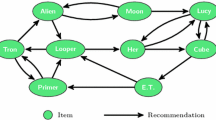Abstract.
One of the main activities of Web users, known as ‘surfing’, is to follow links. Lengthy navigation often leads to disorientation when users lose track of the context in which they are navigating and are unsure how to proceed in terms of the goal of their original query. Studying navigation patterns of Web users is thus important, since it can lead us to a better understanding of the problems users face when they are surfing. We derive Zipf's rank frequency law (i.e., an inverse power law) from an absorbing Markov chain model of surfers' behavior assuming that less probable navigation trails are, on average, longer than more probable ones. In our model the probability of a trail is interpreted as the relevance (or ‘value’) of the trail. We apply our model to two scenarios: in the first the probability of a user terminating the navigation session is independent of the number of links he has followed so far, and in the second the probability of a user terminating the navigation session increases by a constant each time the user follows a link. We analyze these scenarios using two sets of experimental data sets showing that, although the first scenario is only a rough approximation of surfers' behavior, the data is consistent with the second scenario and can thus provide an explanation of surfers' behavior.
Similar content being viewed by others
Author information
Authors and Affiliations
Additional information
Received 31 March 2000 / Revised 27 July 2000 / Accepted in revised form 29 August 2000
Rights and permissions
About this article
Cite this article
Levene, M., Borges, J. & Loizou, G. Zipf's Law for Web Surfers. Knowledge and Information Systems 3, 120–129 (2001). https://doi.org/10.1007/PL00011657
Issue Date:
DOI: https://doi.org/10.1007/PL00011657




